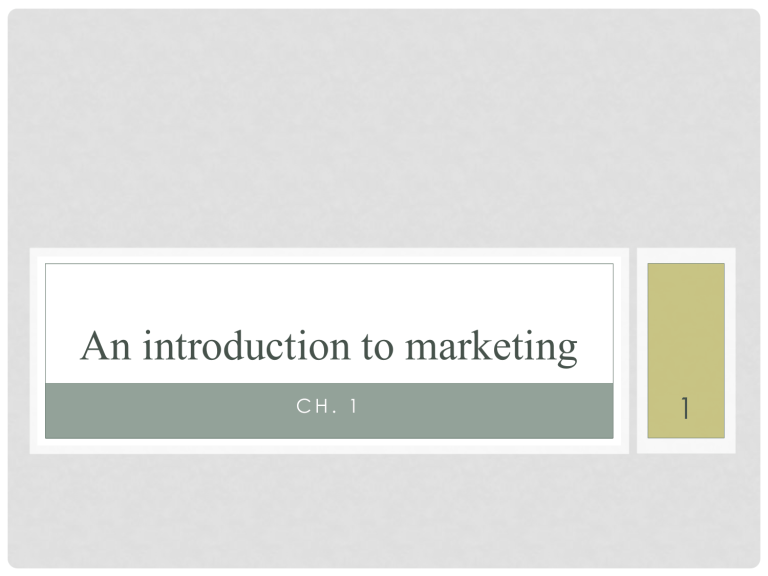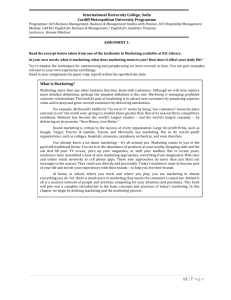
An introduction to marketing CH. 1 1 Marketing • Marketing is about identifying and meeting human and social needs. • One of the shortest good definitions of marketing is “meeting needs profitably.” • The American Marketing Association offers the following formal definition: • Marketing is the activity, set of institutions, and processes for creating, communicating, delivering, & exchanging offerings that have value for customers, clients, partners, & society at large. 2 Marketing management • the art and science of choosing target markets and getting, keeping, and growing customers through creating, delivering, and communicating superior customer value. 3 Marketing Myth • Managers sometimes think of marketing as “the art of selling products,” but many people are surprised when they hear that selling is not the most important part of marketing! • Selling is only the tip of the marketing iceberg. Peter Drucker puts it this way: • The aim of marketing is to know and understand the customer so well that the product or service fits him and sells itself. • Ideally, marketing should result in a customer who is 4 ready to buy. What’s marketed? 1. Physical goods 6. Places 2. Services 7. Properties 3. Experiences 8. Organizations 4. Events 9. Information 5. Persons 10. Ideas 5 Markets • Traditionally, a “market” was a physical place where buyers and sellers gathered to buy and sell goods. • Marketers use the term market to cover various groupings of customers. 1. 2. 3. 4. 5. need markets (the diet-seeking market), product markets (the shoe market), demographic markets (the youth market), geographic markets (the Chinese market); or voter markets, labor markets, and donor markets. 6 Key customer markets 1.Consumer Markets 2.Business Markets 3.Global Markets 4.Nonprofit and Governmental Markets. 7 Needs, wants, and demands • Needs are the basic human requirements such as air, food, water, clothing, & shelter. • These needs become wants when they are directed to specific objects that might satisfy the need. • A U.S. consumer needs food but may want a cheesesteak. A person in Africa needs food but may want rice & lamb. • Wants are shaped by our society. • Demands are wants for specific products backed by an ability to pay. • Many people want a Mercedes; only a few are able to buy one. 8 Needs, wants, and demands • Companies must measure not only how many people want their product, but also how many are willing and able to buy it. • These distinctions shed light on the frequent criticism that “marketers create needs” or “marketers get people to buy things they don’t want.” • Marketers do not create needs: Needs preexist marketers. • Marketers, along with other societal factors, influence wants. • They might promote the idea that a Mercedes would satisfy a person’s need for social status. • They do not, however, create the need for social status. 9 Target markets, segmentation and positioning • Not everyone likes the same restaurant, college, or movie. • Therefore, marketers start by dividing the market into segments. • They identify and profile distinct groups of buyers who might prefer or require varying product and service mixes by examining demographic, psychographic, and behavioral differences among buyers. • After identifying market segments, the marketer decides which present the greatest opportunities (which are its target markets). • For each, the firm develops a market offering that it positions in the minds of the target buyers as delivering some central benefit(s). • Volvo develops its cars for buyers to whom safety is a major concern, positioning its vehicles as the safest a customer can buy. 10 Evolution of marketing • The production concept is one of the oldest concepts in business. • It holds that consumers prefer products that are widely available and inexpensive. • Managers of production-oriented businesses concentrate on achieving high production efficiency, low costs, & mass distribution. • This orientation makes sense in developing countries such as China, where the largest PC manufacturer, Legend (principal owner of Lenovo Group), and domestic appliances giant Haier take advantage of the country’s huge and inexpensive labor pool to dominate the market. • Marketers also use the production concept when they want to 11 expand the market. Evolution of marketing • The product concept proposes that consumers favor products offering the most quality, performance, or innovative features. • However, managers are sometimes caught in a love with their products. • They might commit the “better-mousetrap” myth, believing a better product will by itself lead people to beat a path to their door. • A new or improved product will not necessarily be successful unless it’s priced, distributed, advertised, and sold properly. 12 Evolution of marketing • The selling concept holds that consumers & businesses, if left alone, won’t buy enough of the organization’s products. • It is practiced most aggressively with unwanted goods (goods buyers don’t normally think of buying such as insurance) & when firms with overcapacity aim to sell what they make, rather than make what the market wants. • Marketing based on hard selling is risky. • It assumes customers persuaded into buying a product not only won’t return or bad-mouth it or complain to consumer organizations but might even buy it again. 13 Evolution of marketing • The marketing concept emerged in the mid-1950s as a customer-centered, sense-and-respond philosophy. • The job is to find not the right customers for your products, but the right products for your customers. • The marketing concept holds that the key to achieving organizational goals is being more effective than competitors in creating, delivering, and communicating superior customer value to your target markets. Harvard’s Theodore Levitt drew a perceptive contrast between the selling and marketing concepts: • Selling focuses on the needs of the seller; marketing on the needs of the buyer. • Selling is preoccupied with the seller’s need to convert his product into cash; marketing with the idea of satisfying the needs of the customer by means of the product and the whole cluster of things associated with creating, delivering, and finally consuming it. 14 Evolution of marketing • The Holistic Marketing Concept • Without question, the trends and forces that have defined the first decade of the 21ST century are leading firms to a new set of beliefs and practices. • The holistic marketing concept is based on the development, design, and implementation of marketing programs, processes, and activities that recognize their breadth & interdependencies. • Holistic marketing acknowledges that everything matters in marketing and that a broad, integrated perspective is often necessary. 15 Steps of marketing R STP MM I C 16 = R research STP = Segmentation , Targeting Positioning MM = Marketing Mix = Implementation I C = Control 17 Marketing mix 4 Ps 4 Cs Customer Value القيمة للعميل Cost to the customer التكلفة بالنسبة للعميل Convenience الراحة Communication االتصال Product المنتج Price السعر Place Promotion المكان الترويج 18 Marketing Mix Product Product variety Quality Design Features Brand name Packaging Sizes Services Warranties Returns Price List price Discounts Allowances Payment period Credit terms Marketing Mix Targeted Market Place Channels Coverage Locations Inventory Transport Promotion Sales promotion Advertising Sales force Public relations Direct marketing 19 الدليل المادى الملموس المنتج Product Physical )(evidence التسعير العمليات Price Process التوزيع الناس Place People الترويج Promotion 20




